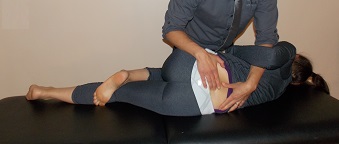Specific Vs. Random Mob = Same!
The RCT investigated the potential benefits of two lumbar mobilization procedures on patients with chronic mechanical low back pain (LBP).
One group of patients received manual therapy mobilizations based on specific findings after a thorough manual examination, while the other patients received randomly assigned mobilizations on various levels into various directions.
E.g. 2 sets of Gr. III PAs over L4 and L5 for 60 seconds, twice a week for 2 weeks.
So which group of patients with LBP do you think did better? The ones who got mobs based on specific findings of hypomobile segments or the ones who received randomly assigned mobs?
Result #1: Both groups showed significant improvements in pain and disability scores after 4 weeks and after 6 months.
Result #2: There were no differences between the two groups with respect to pain and disability scores after 4 weeks and after 6 months.
Result #3: At 6-months follow-up, the patients in the “therapist selected” mob group had greater perception of overall well-being.
Perhaps this is due to the fact that “therapist selected” mobs required greater evaluation procedures and greater feedback from the patient, whereas randomly given treatments did not involve the engagement of the patient in determining the best treatment techniques.
We could hypothesize that patients who are engaged in their treatments may have better outcomes as they may feel that they are giving the therapist valuable input into what intervention is best suited for them. I continue to be a strong supporter of both McKenzie and Mulligan concepts as they both 100% rely on patient input in determining the best treatment. There is something to be said about empowering patients …it is what physiotherapy is!
Conclusion: Other than this recent paper, there are 3 other studies showing similar benefits among patients receiving “therapist selected” and “randomly selected” mobilizations or manipulations. Both groups seem to show equal short-term improvements as long as they receive manual therapy anywhere within their lumbar region.
Personal Comment #1: Until a single study supports it, I will continue to preach that manual therapy assessment based on PIVMs and PAMs is a waste of time! I don’t do it, I don’t teach it.
Personal Comment #2: I think a big flaw in this study was that all patients received the same “standardized home exercise program”. They were all instructed to do daily hamstring & piriformis stretches, quadruped cat and camel for lumbar ROM & prone press-ups.
In my humble opinion, PTs should not be giving “standardized back exercises” …what’s the point in seeing a PT when in fact kinesiologists and personal trainers have full training to do that? The whole purpose of PT is for us to figure out the exercises or movements that specifically suit a patient’s needs and are ideal for their recovery.
I wish PTs in real life and PTs in studies would stop giving “standardized” exercises. It demeans our profession as a whole, but that’s just my 2 cents!


